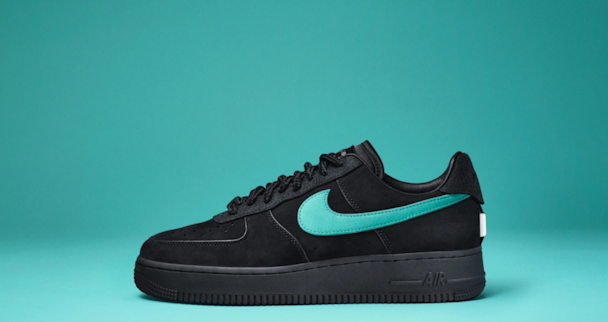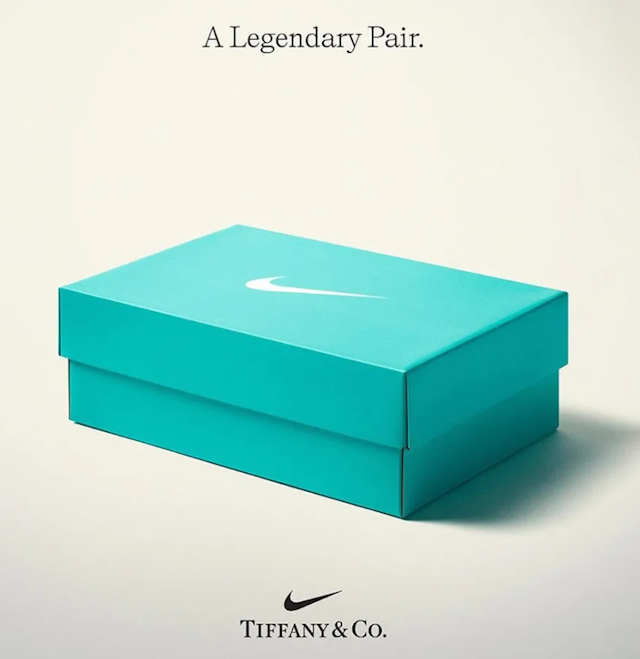‘Collective uncertainty is part of plan’: what’s the deal with Nike Tiffany tie-up?
The sports giant and the luxury jewelry brand announced a brand collaboration this week. And reaction has been mixed.

Nike
For what has been lauded by some commentators as the brand collaboration of the year, the announcement of Nike’s tie-up with Tiffany & Co didn’t quite go to plan.
Marketing assets for a co-branded shoe were leaked to the press, generating confused buzz on social media as people tried to work out if it was legit. Nike’s PR team sprung into action and responded by sharing an image of a shoebox in the iconic Tiffany blue hue alongside the words ‘A Legendary Pair’ across its social media accounts. Nothing more has been said on what’s to come.
This frenzied reveal left many wondering what the thinking was behind the unlikely pairing of two brands, polarizing opinion on whether this is a genius move or a money-grabbing stunt motivated by headlines rather than strategic insight.
Advertisement
On social media, people’s views ranged from “clumsy” and “more about convenience and cash than culture and authenticity” to (perhaps more worryingly for both brands) “boring” in the execution, based on leaked images of a simple blue swoosh on a black Nike Air Force 1.

For analysts, the gains for Tiffany are clear. When LVMH acquired Tiffany & Co in 2021, CEO Bernard Arnault made clear he would accelerate its positioning from tired heritage brand to ultra-modern luxury giant. He spearheaded the brand’s partnership with Beyoncé and Jay-Z, launched a custom jewelry program for holders of CryptoPunks NFTs, signed off on the equally controversial ‘Not Your Mother’s Tiffany’ ad campaign and pushed through a collaboration with Supreme.
Advertisement
The strategy has helped deliver what LVMH called a “record year” for Tiffany in its recent trading update, driven by its “increasing desirability”. This Nike collaboration will undoubtedly supercharge this.
Oliver Lloyd, strategy director at culture and entertainment agency Attachment, says of the LVMH strategy: “It’s these daring culture-focused partnerships that are waking Tiffany & Co – and other brands within the portfolio, like Rimowa – up from its sleepy position in the luxury category and driving relevance again. It’s safe to say they know exactly what they’re doing.”
What it brings to the table for Nike, though, is less easy to understand. John Malozzi, group creative director for the US at Coley Porter Bell, agrees that, for Tiffany, the strategy behind the collaboration makes sense: “It has an aging audience and is trying to attract younger consumers, using Nike’s platform to reach the target demographic.” For Nike, though, he says “the benefit of this partnership is less clear”.
Suggested newsletters for you
Nike is no stranger to collaborating with luxury brands. Its tie-up with Dior, Jaquemus and Louis Vuitton delivered exceptional one-off products and gave Nike (one of the most accessible brands in the world) an air of exclusivity. But, as Malozzi points out, the leaked images of the Tiffany shoe suggest the brand has “played it safe”.
He says: “The most effective brand stretch strategies often go beyond a brand’s comfort zone and enter a new product area or category, but still hold on to a core truth that can resonate in new spaces. And for Nike, that core truth is athletics. The partnership doesn’t seem to affect either brand individually, but it says something about the creative relationship between the two. The outcome of the design feels unresolved and fearful – possibly the result of excessive decision-making at the senior level that forced too many creative compromises.”
While it might have caused a stir on social media, it won’t be enough to create the kind of shockwaves Nike has always managed to achieve with its luxury collabs in the past. The “lukewarm” reaction is exactly what Nike and Tiffany would have expected, however, according to James Kirkham, the founder of Iconic, an agency that helps brands tap into pop culture moments. In fact, leaving the consumer with more questions than answers is all part of the marketing strategy for brands struggling to cut through the sheer volume of collabs on the market right now, Kirkham tells us.
He says: “This initial collective uncertainty is almost certainly part of the intention for brands when they strike a partnership of this sort in 2023. Partnerships are potent right now. Smart audiences do much of the work themselves, spreading assets through their own social streams and further fueling interest. But as collabs increase in their numbers, cutting through now relies on surprise. It is better to bewilder now than be expected, as this will push jaded audiences to respond, creating the conversation that makes the marketing matter.”
The real win for Nike will be further down the line, he concludes. “It will enjoy limited edition impact by being associated with a premium fashion brand. If these products cost $400, sneakerheads are suggesting they’ll resell for $4,000. This is key too, as it merely adds more octane to the hype engine.”

